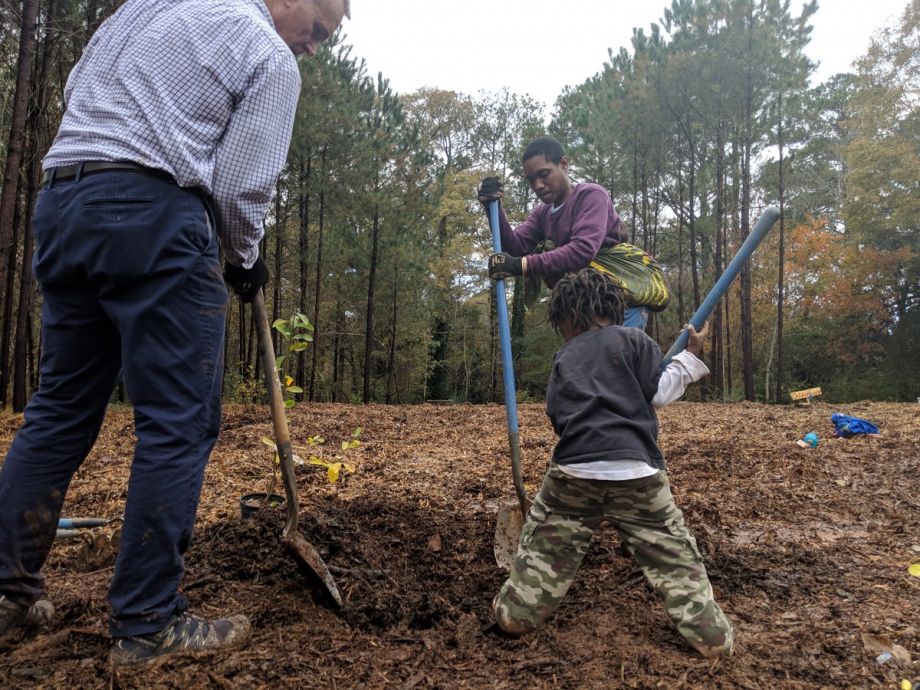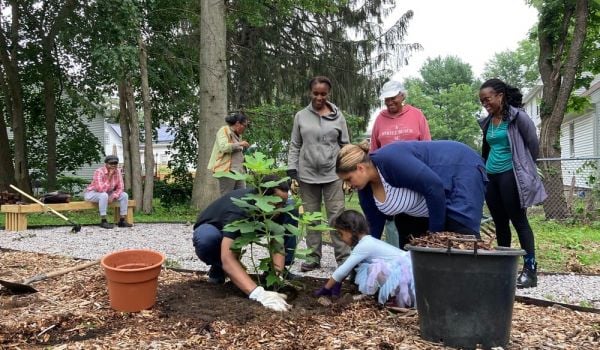People still remember when Ruby and Willie Morgan had a farm in southeast Atlanta. The couple left extra produce on fence posts for their neighbors in Lakewood and Browns Mill Park to take.
That farm ceased operations around 2000, and a few years later, developers bought the property for townhouses. When the recession hit, those plans came to a halt and the land lay abandoned.
Around 2015, Atlanta city councilmember Carla Smith wanted to figure out what to do with the property, which falls in her district.
“We wanted it cleaned up,” she says. “I was having people complaining about how nasty it was because it was so overgrown.”
Now, in a community designated as a food desert with few options for fresh produce, that property is becoming the largest food forest in the U.S. It was officially created in May. Once the seven-acre Urban Food Forest at Browns Mill is fully up and running, anyone will be able to pick produce including muscadines, walnuts, pecans, apples, corn, green beans, thyme, parsley, squash, okra and mushrooms. (Some produce is available now, too.)
It’s among the most prominent efforts to advance edible landscapes throughout Atlanta. The nonprofit Georgia Organics released a recent report studying how Atlanta can have more edible gardens around commercial and other buildings — and what cities nationally can learn. It also confronted the challenges of incorporating edible landscapes into urban settings. The report included 60 interviews with developers, farmers, planners and advocates.
“We have a society that is extremely distant from a relationship with food and agriculture,” says Alice Rolls, president and CEO of Georgia Organics. She says edible landscapes can empower people to grow their own food and improve access to a diversity of fresh produce.
In order to get past financial, management and liability concerns, Atlanta and other cities need public and private sector leadership — in city government, the landscaping industry and elsewhere — that encourages incorporating edible plants within parks and other development, Rolls says.
More schools, colleges and neighborhoods are planting edible landscapes, but so far, they are limited in commercial settings in Atlanta, she says. Some companies are early adopters. For example, Delta Air Lines installed raised beds and an orchard at its headquarters, so employees will be able to pick blueberries, figs, peaches and muscadines.
Financial and management concerns can be a barrier to wider adoption of edible landscapes, according to the report. Landscape design customers cite safety and liability concerns, as well as a perception that these landscapes aren’t as ornamental as other types of gardens.
Rolls says it requires a mental shift to see beauty beyond the typical front yards and planter boxes.
“Part of this is also saying it is aesthetically beautiful to have a blueberry plant,” she says, adding that blueberries aren’t difficult to maintain.
The report also notes that the landscape industry doesn’t have the necessary knowhow to take care of fruit trees, so it will require more training for edible landscapes to take off.
At the food forest, volunteers from Friends of the Urban Food Forest at Browns Mill Park Community Collaborative take care of the 7.1-acre property along with Trees Atlanta. The nonprofit, which aims to protect and improve Atlanta’s urban forest, has hired a food forest ranger and a community liaison. Two beehives help pollinate the plants, and the forest — which is pesticide-free — has a place to compost organic materials. Goats have worked to clear the land that is still overgrown, Councilmember Smith says.
Atlanta’s Department of Parks and Recreation manages the property, which is a public park. The food forest has been in development since 2016 when the city got a grant from the U.S. Forest Service Community Forest and Open Space Conservation Program. Trees Atlanta and The Conservation Fund also support the project.
At food forests, many of the plants are perennials that don’t need replanting season after season, Smith says.
“That’s much different than a community garden,” she says. “Ours is sustainable and it lasts into perpetuity.”
The food forest serves as a signature project that can help further awareness of edible landscapes and lead people to learn more about them, Rolls says.
“That just opens up all sorts of possibilities for inspiring people to do small or large projects throughout the city,” she says.
Someday, after people become more aware of edible landscapes, perhaps LEED certification and low-income housing tax credit programs will include incentives to incorporate them into green building and affordable housing, Rolls says.
“[If] cities around the country start having food forests, that becomes part of our landscaping DNA and that will then inspire the creation of metrics and criteria within certifications that will be inclusive of these types of landscapes,” she says.
The food forest is part of Atlanta Mayor Keisha Lance Bottoms’ plan to ensure 85 percent of city residents are within one-half mile of accessible fresh food by 2022.
“Sometimes you have to use the ground,” Smith says, “not just a grocery store.”
This story is part of The Power of Parks, a series exploring how parks and recreation facilities and services can help cities achieve their goals in wellness, conservation and social equity. The Power of Parks is supported by a grant from the National Recreation and Park Association.
EDITOR’S NOTE: We’ve corrected the deadline on Mayor Keisha Lance Bottoms’ food plan; the goal is 2022, not 2021.

Adina Solomon is a freelance journalist based in Atlanta. She writes on a range of topics with specialties in city design, business and death. Her work has appeared in The Washington Post, CityLab, U.S. News & World Report, and other national and local outlets.
















